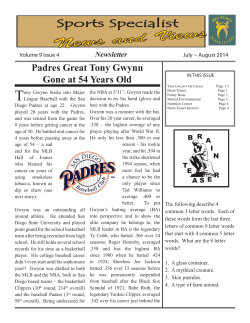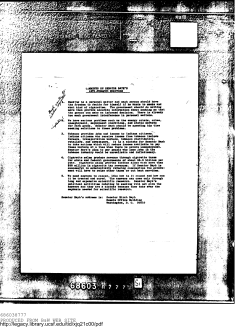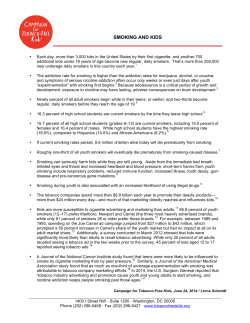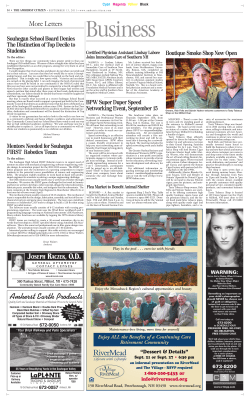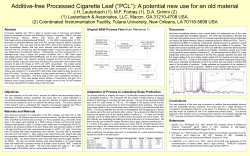
Smokeless Tobacco Fact Sheets 3rd International Conference on Smokeless Tobacco
Smokeless Tobacco Fact Sheets September 22-25, 2002 3rd International Conference on Smokeless Tobacco Advancing Science & Protecting Public Health Smokeless Tobacco Fact Sheets Introduction Smokeless tobacco products have been in existence for thousands of years among populations in South America and Southeast Asia. Over time, these products have gained popularity in the throughout the world. Smokeless tobacco is consumed without burning the product, and can be used orally or nasally. Oral smokeless tobacco products are placed in the mouth, cheek or lip and sucked (dipped) or chewed. Tobacco pastes or powders are used in a similar manner and placed on the gums or teeth. Fine tobacco powder mixtures are usually inhaled and absorbed in the nasal passages. There is sufficient evidence that the use of smokeless tobacco causes cancer in humans. Smokeless tobacco contains carcinogens, which contribute to cancers of the oral cavity and the risk of other head and neck cancers. Smokeless tobacco use also causes a number of noncancerous oral conditions and can lead to nicotine addiction similar to that produced by cigarette smoking. This compendium of fact sheets on smokeless tobacco products includes information about the brand and common names of the products, their geographic location of use, their constituents (ingredients), how the products are used, who primarily uses the products, and the processes for manufacturing the products. This information has been organized by geographic region of the world – the Americas, Europe, Asia, Africa and the Middle East. These fact sheets were prepared by NCI and CDC specifically for the participants of the “3rd International Conference on Smokeless Tobacco, Advancing Science & Protecting Public Health,” September 22-25, 2002, Stockholm, Sweden. They are works in progress and should be considered drafts. Any additional information on smokeless tobacco products would be greatly appreciated for the development of future editions. Please forward additional information to: Michelle Roland, PhD Office on Smoking and Health Centers for Disease Control and Prevention 4770 Buford Highway, N.E. Mailstop K-50 Atlanta, GA 30341-3717 Tel: (770) 488 – 5582 mroland@cdc.gov Co-Chairs, Program Committee, 3rd International Conference on Smokeless Tobacco: Samira Asma, DDS, MPH Director for Global Tobacco Control Programs Office on Smoking and Health Centers for Disease Control and Prevention Cathy Backinger, PhD, MPH Health Scientist Tobacco Control Research Branch National Cancer Institute Acknowledgements The following people significantly contributed to the development of the smokeless tobacco fact sheets: Samira Asma, DDS, MPH Office on Smoking and Health, Centers for Disease Control and Prevention, Atlanta, GA, USA Cathy Backinger, PhD, MPH Tobacco Control Research Branch, National Cancer Institute, Bethesda, MD, USA Bill Blatt, MPH, CHES Tobacco Control Research Branch, National Cancer Institute, Bethesda, MD, USA Maria Rosaria Galanti, PhD Karolinska Institutet, Stockholm, Sweden Rachel Grana, BSHS MasiMax Resources, Inc., Rockville, MD, USA Ricardo Granero, MD, MHSc Research Center Ascardio, Barquisimeto, Venezuela Prakash Gupta, DSc, FACE Tata Institute of Fundamental Research, India Ali Idris, BDS, MSc, PhD Toombak and Smoking Research Center, Khartoum, Sudan Brian Judd Office on Smoking and Health, Centers for Disease Control and Prevention, Atlanta, GA, USA Michelle Roland, PhD Office on Smoking and Health, Centers for Disease Control and Prevention, Atlanta, GA, USA Susan Giarratano Russell, EdD, MSPH, CHES Office on Smoking and Health, Centers for Disease Control and Prevention, Atlanta, GA, USA Scott Tomar, DMD, DrPH University of Florida College of Dentistry, Gainesville, FL, USA Smokeless Tobacco Products by Region of the World Regions I. Products Americas North America Chewing tobacco Loose leaf Plug - moist Plug - chew Twist or roll Snuff Dry Iq'mik Ariva (nicotine lozenge) Moist South America Chimo (Venezuela) II. IV. 3 4 5 6 18 9 2 19 1 Europe Snus or snuff (Sweden) Gutkha (United Kingdom) Dry snuff (United Kingdom) III. Page 20 8 18 Asia Central Asia1 Gul Nass or Naswar, Niswar Pan Masala or Betel quid Zarda East/Southeast Asia2 Gutkha Pan Masala or Betel quid South Asia, including Indian subcontinent3 Creamy snuff Gul Gutkha Khaini Mawa Mishri or Masheri, Misheri Qiwam or Kima Red Tooth Powder Snus or snuff 17 7 8 10 12 13 11 22 20 Middle East (Iran, Saudi Arabia, Arab countries) Nass or Naswar, Niswar Shammah Zarda 14 16 23 Africa (Sudan) Toombak Reference list 7 14 15 23 8 15 V. 1 2 3 21 24 Uzbekistan, Turkmenistan, Tajikistan, Kyrgyzstan, Kazakstan, E. Turkestan (Xinijiang), Afghanistan, Pakistan, Baluchistan, Mongolia, parts of Iran Philippines, New Guinea, Indonesia, Singapore, Malaysia, Cambodia, Thailand, Myanmar India, Western & Central States of India, Bihar, Maharashtra, Gujarat, Bhavnagar, Sri Lanka Chimó BRAND NAMES: San Carleño, El Tovareño, El Tigrito, El Sabroso, El Gran Búfalo, El Dragón, El Morichal COMMON NAMES: None GEOGRAPHIC LOCATION OF USE: Venezuela PRODUCT CONSTITUENTS: Tobacco leaf, sodium bicarbonate, brown sugar, ashes from the Mamón tree (Meliccoca bijuga), and vanilla and anisette flavoring. The ingredients vary according to the region within Venezuela. HOW USED: A small amount of Chimó is placed between the lip or cheek and the gum and left there for some time, usually 30 minutes. The mixture of Chimó and saliva is spit out. WHO USES: Children, teenagers, unskilled workers in rural and urban areas. Chimó use has become fashionable in the last 5 years among urban teenagers, regardless of social and economic status. PROCESSING / MANUFACTURING: Tobacco leaves are crushed and boiled for several hours, starch and fiber are discharged. The remaining portion becomes a concentrated product, 10 kilos of tobacco becomes one kilo of “Pasta”. For maturation it is then placed in natural containers, or “taparas”(the dried fruit from Tapara tree), or wrapped in banana leaves. The matured paste is “seasoned” with other ingredients, listed above. Finally packaged in small tins or candy-like wrapped cylinders. Most factories are small. Bhonsle RB, Murti PR, Gupta PC. Tobacco habits in India. In: Gupta PC, Hamner JE, Murti PR, editors. Control of Tobacco-Related Cancers and Other Diseases. Proceedings of an International Symposium; 1990 Jan 15-19; TIFR, Bombay, India. Oxford University Press 1992. p. 25-46. Novoa D, Maudell W, Ross A, Torres R, Escaffi P. Chimó a risk factor for chronic cardiopathy in rural chagasic and non-chagasic Venezuelan adults. Presentation at the XI Congreso Latinoamericano de Parasitología. Lima, Perú; 1993. Persson PG, Carlsson S, Svanstrom L, Ostenson CG, Efendic S, Grill V. Cigarette smoking, oral moist snuff use and glucose intolerance. J Intern Med. 2000 Aug;248 (2):103-10. Seelkopf C, Rojas A. Estudio sobre el Chimó. Universidad de Los Andes, Venezuela. Wilbert J. The cultural significance of tobacco use in South America. In: Seaman G, Day JS, editors. Ancient Traditions: Shamanism in Central Asia and the Americas. Denver: University Press of Colorado & Denver Museum of Natural History; 1994. p. 47-76. -1- Nicotine Lozenge BRAND NAMES: Ariva COMMON NAMES: None GEOGRAPHIC LOCATION OF USE: United States PRODUCT CONSTITUENTS: tobacco, mint, eucalyptus HOW USED: Held in mouth and sucked until dissolved. WHO USES: Not yet determined. PROCESSING / MANUFACTURING: Commercially manufactured by Star Scientific. -2- Loose Leaf Chew BRAND NAMES: Red Man, Red Man Golden Blend, Red Man Select, Granger, Work Horse (Swedish Match products), Scotten, Dillon, Levi Garrett, HB Scott, Taylors Pride, Red Fox (Conwood products), Beech-Nut Regular, Beech-Nut Wintergreen, Beech-Nut Spearmint (National products), Chattanooga Chew (Swisher product) COMMON NAMES: chewing tobacco, spit tobacco GEOGRAPHIC LOCATION OF USE: United States PRODUCT CONSTITUENTS: leaf tobacco, sweetener, and/or licorice HOW USED: A piece of tobacco 0.75 to 1 inch in diameter is placed between the cheek and lower lip, typically toward the back of the mouth. It is either chewed or held in place.1 Saliva is spit or swallowed. WHO USES: In 2000, U.S. prevalence of current (used within the past 30 days) smokeless tobacco use (includes both snuff and chewing tobacco) for those 12 years old and over was 3.4%: 6.5% of males and 0.5% of females.2 PROCESSING / MANUFACTURING: Commercially manufactured. Loose cigar tobacco leaves are air-cured, then stemmed, cut or granulated and loosely packed to form small strips of shredded tobacco. Most brands are sweetened and flavored with licorice. Typically sold in pouches weighing about 3 ounces.1 Loose-leaf tobacco has a high average sugar content (approximately 35%).3 1 Asma, S. (1998). Definitions of tobacco products. Unpublished Work 2 Substance Abuse and Mental Health Services Administration. Summary of Findings from the 2000 National Household Survey on Drug Abuse. Office of Applied Studies, NHSDA Series H-13, DHHS Publication No. (SMA) 013549. Rockville, MD, 2001. 3 Severson HH. The S.T.O.P Guide: Smokeless Tobacco Outreach & Prevention. 1 ed. Point Richmond (CA): Applied Behavior Science Press; 1997. -3- Moist Plug BRAND NAMES: Red Man Moist Plug, Totems, RJ Gold (Swedish Match products), Levi Garrett Plus, Taylors Pride (Conwood products) COMMON NAMES: chewing tobacco, spit tobacco GEOGRAPHIC LOCATION OF USE: United States PRODUCT CONSTITUENTS: enriched tobacco leaves, fine tobacco, sweetener, and/or licorice HOW USED: Chewed or held between the cheek and lower lip.1 Saliva is spit or swallowed. WHO USES: In 2000, U.S. prevalence of current (used within the past 30 days) smokeless tobacco use (includes both snuff and chewing tobacco) for those 12 years old and over was 3.4%: 6.5% of males and 0.5% of females.2 PROCESSING / MANUFACTURING: Commercially manufactured. Enriched tobacco leaves (Burley and bright tobacco or cigar tobacco) or fragments are wrapped in fine tobacco and pressed into bricks. Moist plug tobacco has at least 15% moisture. Most plug tobacco is flavored and sweetened with licorice. Plus tobacco is packaged as a compressed brick or flat block wrapped inside natural tobacco leaves. Typically weighs 7 to 13 ounces.1 Sugar content is approximately 24%.3 1 Asma, S. (1998). Definitions of tobacco products. Unpublished Work. 2 Substance Abuse and Mental Health Services Administration. Summary of Findings from the 2000 National Household Survey on Drug Abuse. Office of Applied Studies, NHSDA Series H-13, DHHS Publication No. (SMA) 013549. Rockville, MD, 2001. 3 Severson HH. The S.T.O.P Guide: Smokeless Tobacco Outreach & Prevention. 1st ed. Point Richmond (CA): Applied Behavior Science Press; 1997. -4- Plug (chew) BRAND NAMES: Days Work (Swedish Match product), Conwood (Conwood product), Brown & Williamson (Brown & Williamson product) COMMON NAMES: chewing tobacco, spit tobacco GEOGRAPHIC LOCATION OF USE: United States PRODUCT CONSTITUENTS: enriched tobacco leaves, fine tobacco, sweetener and/or licorice HOW USED: Chewed or held between the cheek and lower lip.1 Saliva is spit or swallowed. WHO USES: In 2000, U.S. prevalence of current (used within the past 30 days) smokeless tobacco use (includes both snuff and chewing tobacco) for those 12 years old and over was 3.4%: 6.5% of males and 0.5% of females.2 PROCESSING / MANUFACTURING: Enriched tobacco leaves (Burley and bright tobacco and cigar tobacco) or fragments are wrapped in fine tobacco and pressed into bricks. Plus or “firm plug” tobacco has less than 15% moisture. Most plug tobacco is flavored and sweetened with licorice. Plus tobacco is packaged as a compressed brick or flat block wrapped inside natural tobacco leaves. Package typically weighs 7 to 13 ounces.1 1 Asma, S. (1998). Definitions of tobacco products. Unpublished Work 2 Substance Abuse and Mental Health Services Administration. Summary of Findings from the 2000 National Household Survey on Drug Abuse. Office of Applied Studies, NHSDA Series H-13, DHHS Publication No. (SMA) 013549. Rockville, MD, 2001. -5- Twist Roll (chew) BRAND NAMES: Conwood (Conwood product), R.C. Owen (R.C. Owen product), R.J. Reynolds (R.J. Reynolds product) COMMON NAMES: chewing tobacco, spit tobacco GEOGRAPHIC LOCATION OF USE: United States PRODUCT CONSTITUENTS: tobacco, tobacco leaf extract HOW USED: Chewed or held between the cheek and lower lip.1 Saliva is spit or swallowed. WHO USES: In 2000, U.S. prevalence of current (used within the past 30 days) smokeless tobacco use (includes both snuff and chewing tobacco) for those 12 years old and over was 3.4%: 6.5% of males and 0.5% of females.2 PROCESSING / MANUFACTURING: Handmade by commercial manufacturers. Dark, aircured leaf tobacco is treated with a tar-like tobacco leaf extract and twisted into rope-like strands that are dried. Typically, no flavoring or sweetener is added. The final product is a pliable, but dry, rope. The product is sold by the piece in small (1 to 2 ounce) or larger sizes based on the number of leaves in the twist.1 1 Asma, S. (1998). Definitions of tobacco products. Unpublished Work. 2 Substance Abuse and Mental Health Services Administration. Summary of Findings from the 2000 National Household Survey on Drug Abuse. Office of Applied Studies, NHSDA Series H-13, DHHS Publication No. (SMA) 013549. Rockville, MD, 2001. -6- Gul BRAND NAMES: None COMMON NAMES: Gadakhu GEOGRAPHIC LOCATION OF USE: Central and Eastern India1 PRODUCT CONSTITUENTS: tobacco powder, molasses, other ingredients HOW USED: Often used for cleaning teeth.1 WHO USES: Primarily women.2 PROCESSING / MANUFACTURING: Commercially manufactured. Since 1986, gul has been machine produced and sold in toothpaste-like tubes.3 Photo not available 1 Puttaiah R., Carley K., Holavanahalli R. Tobacco, betel-quid chewing and oral health. In: Bedi R, Jones P, editors. Betel-quid chewing and tobacco chewing among the Bangladeshi community in the United Kingdom. London: Centre for Transcultural Oral Health; 1995. p.1-9. 2 Gupta, P. (2001). Regional Summary for Southeast Asia World Health Organization. 3 Trends in tobacco use (2001c). [On-line]. Available: http://www.doctoronnet.com/addictions/2trends.php3 -7- Gutkha BRAND NAMES: Manikchand, Moolchand, Tulsi, Shimla, Sikandar, Pan Parag COMMON NAMES: None GEOGRAPHIC LOCATION OF USE: India, Southeast Asia, United Kingdom1 PRODUCT CONSTITUENTS: betel nut, catachu, tobacco, lime, saffron, flavoring HOW USED: Held in the mouth and chewed. Saliva is generally spit out, but sometimes swallowed.1 WHO USES: Very popular among boys and young men due to targeted advertising and marketing. PROCESSING / MANUFACTURING: Commercially manufactured. Tobacco, betel nut and catechu are mixed together with several other ingredients, flavored, and sweetened. Product is sold in small brightly-colored packets, which appeal to children.1,2 1 Gangwal, K. (2001). What is gutkha? [On-line]. Available:http://www.antigutkha.com/what_is_gutkha.html 2 Gupta PC. Gutka: a major new tobacco hazard in India. Tob Control 1999;8:132. -8- Iq’mik BRAND NAMES: None COMMON NAMES: None GEOGRAPHIC LOCATION OF USE: Alaska (United States) PRODUCT CONSTITUENTS: tobacco, punk ash1 HOW USED: Users pinch off a small piece and chew the iq’mik. The user may pre-chew the iq’mik and place it in a small box for later use by others, including children and sometimes teething babies.2 WHO USES: Alaska Natives (men, women and children).1 One study found that 52% of YukonKuskokwim Delta Alaska Natives used iq’mik.2 PROCESSING / MANUFACTURING: Fire-cured tobacco leaves are mixed with punk ash (ash generated by burning a woody fungus that grows on the bark of birch trees). The ingredients are available at grocery stores and retail outlets, but are generally combined by the user before use.1 It is believed that the punk ash in the mixture raises the pH level in the mouth, increasing the dose and enhancing the delivery of nicotine to the brain.2 Punk, whole fungus Fire cured tobacco leaves for sale Punk ash for sale in local grocery store 1 J. Kaur & F.E. Jackson (personal communication, March 27, 2001). 2 Gerjevic S. Iq’mik use a 'pediatric epidemic' in Y-K Delta. Fairbanks Daily News-Miner 2002 Jan 6. -9- Khaini BRAND NAMES: Raja, Kuber COMMON NAMES: None GEOGRAPHIC LOCATION OF USE: Bihar (India), Western and central states of India,1 Maharashtra (India)2 PRODUCT CONSTITUENTS: tobacco, slaked lime paste, 3 sometimes areca nut HOW USED: Held in the mouth, in a similar manner to moist snuff.4 The product is kept in the mouth for 10 to 15 minutes5 and sucked from time to time.2 WHO USES: Most common among men but used by women as well. PROCESSING / MANUFACTURING: Powdered tobacco and slaked lime paste are combined by the user in his/her palm and formed into a ball.6 Areca nut is sometimes added.1 Usually prepared by a user from basic ingredients at the time of use. 1 Puttaiah R., Carley K., Holavanahalli R. Tobacco, betel-quid chewing and oral health. In: Bedi R, Jones P, editors. Betel-quid chewing and tobacco chewing among the Bangladeshi community in the United Kingdom. London: Centre for Transcultural Oral Health; 1995. p.1-9. 2 Murti P, Gupta P, Bhonsle R. Betel quid and other smokeless tobacco habits in India: oral health consequences. Dent J Malaysia 1997;18:16-22. 3 US Department of Health and Human Services. Health consequences of using smokeless tobacco: a report of the Advisory Committee to the Surgeon General. Bethesda, Maryland: US Department of Health and Human Services, Public Health Service, 1986. 4 World Health Organization. Tobacco or health: a global status report. Geneva: World Health Organization, 1997. 5 William S. Betel-quid chewing: a community perspective. In: Bedi R, Jones P, editors. Betel-quid chewing and tobacco chewing among the Bangladeshi community in the United Kingdom. London: Centre for Transcultural Oral Health; 1995. 6 Trends in tobacco use (2001c). [On-line]. Available: http://www.doctoronnet.com/addictions/2trends.php3 - 10 - Qiwam (kimam) BRAND NAMES: None COMMON NAMES: None GEOGRAPHIC LOCATION OF USE: India PRODUCT CONSTITUENTS: tobacco, spices (cardamom, saffron and/or aniseed), additives such as musk1 HOW USED: Paste is placed in the mouth and chewed.2 Also used in betel quid. WHO USES: Upper socio-economic groups. PROCESSING / MANUFACTURING: Tobacco leaves are processed by removing their stalks and stems, then boiled and soaked in water flavored with spices and additives. The resulting pulp is mashed, strained, and dried into a paste.1,2 1 Puttaiah R., Carley K., Holavanahalli R. Tobacco, betel-quid chewing and oral health. In: Bedi R, Jones P, editors. Betel-quid chewing and tobacco chewing among the Bangladeshi community in the United Kingdom. London: Centre for Transcultural Oral Health; 1995. p.1-9. 2 Trends in tobacco use (2001c). [On-line]. Available: http://www.doctoronnet.com/addictions/2trends.php3 - 11 - Mawa BRAND NAMES: None COMMON NAMES: None GEOGRAPHIC LOCATION OF USE: Bhavnagar (India), Gujarat1 PRODUCT CONSTITUENTS: tobacco, slaked lime, areca nut HOW USED: Placed in the mouth and chewed for 10 to 20 minutes. WHO USES: Young men. PROCESSING / MANUFACTURING: Small pieces of sun-cured areca nut are mixed with tobacco flakes and slaked lime (liquid calcium hydroxide). The mixture is rubbed together to combine. The resulting mixture is about 95% areca nut. 1 Murti P, Gupta P, Bhonsle R. Betel quid and other smokeless tobacco habits in India: oral health consequences. Dent J Malaysia 1997;18:16-22. - 12 - Mishri (masheri, misheri) BRAND NAMES: None COMMON NAMES: None GEOGRAPHIC LOCATION OF USE: Maharashtra (India) PRODUCT CONSTITUENTS: tobacco HOW USED: Applied to the teeth and gums,1 often for the purpose of cleaning the teeth.2 Users then tend to hold it in their mouths (due to the nicotine addiction).3 WHO USES: Predominantly women. More common in lower socio-economic groups. PROCESSING / MANUFACTURING: Tobacco is baked on a hot metal plate until toasted or partially burnt,4 then powdered. Woman applying Mishri to gums and teeth 1 Murti P, Gupta P, Bhonsle R. Betel quid and other smokeless tobacco habits in India: oral health consequences. Dent J Malaysia 1997;18:16-22. 2 World Health Organization. Tobacco or health: a global status report. Geneva: World Health Organization, 1997. 3 Puttaiah R., Carley K., Holavanahalli R. Tobacco, betel-quid chewing and oral health. In: Bedi R, Jones P, editors. Betel-quid chewing and tobacco chewing among the Bangladeshi community in the United Kingdom. London: Centre for Transcultural Oral Health; 1995. p.1-9. 4 US Department of Health and Human Services. Health consequences of using smokeless tobacco: a report of the Advisory Committee to the Surgeon General. Bethesda, Maryland: US Department of Health and Human Services, Public Health Service, 1986. - 13 - Nass (naswar, niswar) BRAND NAMES: None COMMON NAMES: naswar, niswar GEOGRAPHIC LOCATION OF USE: Central Asia, Iran, Afghanistan, Pakistan, Baluchistan (India)4 PRODUCT CONSTITUENTS: Nass: tobacco, ash, cotton or sesame oil,1 water, and sometimes gum.2 Naswar, niswar: tobacco, slaked lime, indigo, cardamom, oil, menthol, water. HOW USED: Held in the mouth for 10 to 15 minutes. Naswar is sometimes chewed slowly.3 WHO USES: Information not available. PROCESSING / MANUFACTURING: Sun- and heat-dried tobacco leaves, slaked lime, ash from tree bark, and flavoring and coloring agents are mixed together. Water is added and the mixture is rolled into balls.5 Photo not available 1 US Department of Health and Human Services. Health consequences of using smokeless tobacco: a report of the Advisory Committee to the Surgeon General. Bethesda, Maryland: US Department of Health and Human Services, Public Health Service, 1986. 2 Doshi, S. (2001). Tobacco. [On-line]. Available: http://www.doctorsaab.com/asppages/tobacco.asp 3 World Health Organization. Tobacco or health: a global status report. Geneva: World Health Organization, 1997. 4 Maher R. Chewing of various types of quids in Pakistani population and their associated lesions. Dent J Malaysia 1997;18:12-15. 5 Trends in tobacco use (2001c). [On-line]. Available: http://www.doctoronnet.com/addictions/2trends.php3 - 14 - Pan Masala (betel quid) BRAND NAMES: Manikchand, Mahak, Pan Parag #1, Vimal, Crane, Rajdarbar, Kuber, Yamu, Badshah, Tulsi, Rahat, Pan King, Jubilee, Kanchan1 COMMON NAMES: betel quid GEOGRAPHIC LOCATION OF USE: India, Sri Lanka, Pakistan, Bangladesh, Myanmar, Thailand, Cambodia, Malaysia, Singapore, Indonesia, Philippines, New Guinea, Taiwan, China3 PRODUCT CONSTITUENTS: Tobacco, areca nuts, slaked lime, betel leaf.2 “Chewing tobacco” is sometimes used, and flavoring agents such as menthol, camphor, sugar, rosewater, aniseed, mint, or other spices are sometimes added in different regions. 3,4 HOW USED: A quid is placed in the mouth (usually between the gum and cheek) and gently sucked and chewed.4 Pan masala is sometimes served in restaurants after the meal.4 WHO USES: Most common among women, but used by men as well. PROCESSING / MANUFACTURING: Commercially prepared, vendor prepared or assembled at home.5 Areca nut is boiled, roasted, or sun-dried.3 Tobacco may be used raw, sun-dried, and roasted, then finely chopped, powdered and scented. Alternatively, the tobacco may be boiled, made into a paste and scented with rosewater or perfume. To assemble, slaked lime and catechu are smeared on a betel leaf. The betel leaf is folded into a funnel shape and tobacco, areca nut and any other ingredients are added. The top of the funnel is folded over, resulting in a quid, which is placed in the mouth for use.4 Handmade Manufactured 1 Halarnkar S. A New Way to Die? India Today 1997 Aug 11; p. 72-73. 2 World Health Organization. Tobacco or health: a global status report. Geneva: World Health Organization, 1997. 3 Puttaiah R., Carley K., Holavanahalli R. Tobacco, betel-quid chewing and oral health. In: Bedi R, Jones P, editors. Betel-quid chewing and tobacco chewing among the Bangladeshi community in the United Kingdom. London: Centre for Transcultural Oral Health; 1995. p.1-9. 4 William S. Betel-quid chewing: a community perspective. In: Bedi R, Jones P, editors. Betel-quid chewing and tobacco chewing among the Bangladeshi community in the United Kingdom. London: Centre for Transcultural Oral Health; 1995. 5 Gupta, P. (2001). Regional Summary for Southeast Asia World Health Organization. - 15 - Creamy Snuff BRAND NAMES: Ipco (Asha Industries product)1, Denobac, Tona, Ganesh COMMON NAMES: tobacco toothpaste GEOGRAPHIC LOCATION OF USE: India PRODUCT CONSTITUENTS: tobacco, clove oil, glycerin, spearmint, menthol, camphor HOW USED: Often used to clean teeth.2 The manufacturer recommends letting the paste linger in the mouth before rinsing.1 WHO USES: Primarily women.3 PROCESSING / MANUFACTURING: Commercially manufactured. Sometimes marketed as a dentifrice. 1 Ipco creamy snuff. (2001). [On-line]. Available: http://www.ipcosnuff.com/creamy.htm 2 World Health Organization. Tobacco or health: a global status report. Geneva: World Health Organization, 1997. 3 Gupta, P. (2001). Regional Summary for Southeast Asia World Health Organization. - 16 - Dry Snuff BRAND NAMES: Al Capone Powder, Conwood (Conwood product), Swisher (Swisher product), US Tobacco (U.S. Tobacco product), Brown & Williamson (Brown & Williamson product) COMMON NAMES: tapkeer GEOGRAPHIC LOCATION OF USE: United States, United Kingdom, India PRODUCT CONSTITUENTS: tobacco HOW USED: Typically, a pinch is held between the lip and gum or cheek. It may also be inhaled into the nostrils.1 WHO USES: In 2000, U.S. prevalence of current (used within the past 30 days) smokeless tobacco use (includes both snuff and chewing tobacco) for those 12 years old and over was 3.4%: 6.5% of males and 0.5% of females.2 PROCESSING / MANUFACTURING: Tobacco is fire-cured, then fermented and processed into a dry, powdered form. The moisture content of the finished product is less than 10%. It is packaged and sold in small metal or glass containers.1 1 Asma, S. (1998). Definitions of tobacco products. Unpublished Work. 2 Substance Abuse and Mental Health Services Administration. Summary of Findings from the 2000 National Household Survey on Drug Abuse. Office of Applied Studies, NHSDA Series H-13, DHHS Publication No. (SMA) 013549. Rockville, MD, 2001. - 17 - Moist Snuff BRAND NAMES: Copenhagen, Skoal, Skoal Bandits, Happy Days (U.S. Tobacco products), Hawken, Kodiak (Conwood products), Red Wood, Gold River, Silver Creek (Swisher products), Red Man, Timber Wolf, (Swedish Match products) COMMON NAMES: spit tobacco, dip GEOGRAPHIC LOCATION OF USE: United States PRODUCT CONSTITUENTS: tobacco HOW USED: A pinch (called a dip) or a pouch is placed and held between the lip and cheek or gum.1 Saliva may be swallowed or, more commonly, spit out. WHO USES: In 2000, U.S. prevalence of current (used within the past 30 days) smokeless tobacco use (includes both snuff and chewing tobacco) for those 12 years old and over was 3.4%: 6.5% of males and 0.5% of females.2 PROCESSING / MANUFACTURING: The tobacco is either air- or fire-cured, then processed into fine particles (“fine cut”) or strips (“long cut”). Tobacco stems and seeds are not removed. Moisture content of the final product is up to 50%. The tobacco is sold either loose (in such products as Skoal, Copenhagen and Kodiak), or packaged in small, ready-to-use pouches called packets or sachets (in such products as Skoal Bandits). Nicotine is released more rapidly from the fine cut form due to the greater surface area. Moist snuff is the most commonly used form of tobacco in the United States.1 Short cut Long cut Long cut flavored 1 Asma, S. (1998). Definitions of tobacco products. Unpublished Work. 2 Substance Abuse and Mental Health Services Administration. Summary of Findings from the 2000 National Household Survey on Drug Abuse. Office of Applied Studies, NHSDA Series H-13, DHHS Publication No. (SMA) 013549. Rockville, MD, 2001. - 18 - Snus (snuff) BRAND NAMES: Catch, General, Timber Wolf (Swedish match products) COMMON NAMES: None GEOGRAPHIC LOCATION OF USE: Sweden, India 4 PRODUCT CONSTITUENTS: tobacco, water, sodium carbonate, sodium chloride, moisturizer, flavoring, nicotine1 HOW USED: A pinch (called a dip) is placed between the gum and upper lip.2 The average user keeps snus in the mouth for 11 to 14 hours per day. In Sweden, the portions come in two different doses: regular and “mini-portions” (1.0g and 0.5g of tobacco). WHO USES: Approximately 20% of Swedish men and about 2% of Swedish women use snus daily.3 The number of women using snus is increasing.1 PROCESSING / MANUFACTURING: Finely ground dry tobacco is mixed with aromatic substances, salts, water, and humidifying agents. The product is kept cold to avoid fermentation. The final product has a moisture content of about 50% and has a damp consistency.3 Eucalyptus flavored 1 Bolinder, G. (1997). Long-term use of smokeless tobacco: cardiovascular mortality and risk factors Stockholm: Karolinska Institute. 2 Idris A, Ibrahim S, Vasstrand E, Johannessen A, Lillehaug J, Magnusson B, Wallstrom M, Hirsch J, Nilsen R. Swedish snus and the Sudanese toombak: are they different? Oral Oncol 2001; 34: 558-566. 3 Ryden C, Wallskar H. Progress & Challenge: Tobacco Control (Swedish Style). 2000. Stockholm, National Institute of Public Health. Ref Type: Pamphlet 4 Gupta PC. India: Swedish Match steps in. Tob Control 2001 Dec;10(4):304E. - 19 - Toombak BRAND NAMES: None COMMON NAMES: None GEOGRAPHIC LOCATION OF USE: Sudan PRODUCT CONSTITUENTS: tobacco, sodium bicarbonate HOW USED: Product is rolled into a ball, weighing about 10g, called a saffa. The saffa is held between the gum and the lip or cheek, or under the tongue on the floor of the mouth. It is sucked slowly for 10 to 15 minutes. Male users periodically spit, while female users typically swallow the saliva generated. The user usually rinses his/her mouth with water after the saffa is removed.1 WHO USES: About 34% of Sudanese men and 2.5% of women aged 18 years and older.1 PROCESSING / MANUFACTURING: Tobacco leaves are harvested and left in a field for uniform drying. The leaves are then tied into bundles, sprinkled with water, and stored for a couple of weeks at 30 to 45ºC to allow fermentation. The leaves are then ground up and aged for up to a year. After aging, toombak vendors (in toombak shops) place the product in bowls and gradually add sodium bicarbonate until the mixture is approximately 4 parts tobacco to 1 part sodium bicarbonate. The mixture is blended by hand and constantly tested with the tips of the fingers until it becomes moist and hardened. The toombak is then placed in an airtight container for about 2 hours prior to sale.1 Toombak wholesale advertisement Toombak processed by hand 1 Idris A, Ibrahim S, Vasstrand E, Johannessen A, Lillehaug J, Magnusson B, Wallstrom M, Hirsch J, Nilsen R. Swedish snus and the Sudanese toombak: are they different? Oral Oncol 2001; 34: 558-566. - 20 - Red Tooth Powder BRAND NAMES: Dabur COMMON NAMES: lal dantmanjan GEOGRAPHIC LOCATION OF USE: India PRODUCT CONSTITUENTS: tobacco HOW USED: Most often used to clean teeth. WHO USES: More often used by women. PROCESSING / MANUFACTURING: Unknown - 21 - Zarda BRAND NAMES: Baba, Bharat, Gopal COMMON NAMES: None GEOGRAPHIC LOCATION OF USE: India, Arab countries PRODUCT CONSTITUENTS: tobacco, lime, spices, vegetable dyes, areca nut HOW USED: Often used as ingredient in betel quid.1 Chewed. WHO USES: Men and women in middle to upper socio-economic groups. PROCESSING / MANUFACTURING: Tobacco leaves are broken up and boiled with lime and spices. The mixture is dried and colored with vegetable dyes, then mixed with finely chopped areca nuts.2 1 World Health Organization. Tobacco or health: a global status report. Geneva: World Health Organization, 1997. 2 Puttaiah R., Carley K., Holavanahalli R. Tobacco, betel-quid chewing and oral health. In: Bedi R, Jones P, editors. Betel-quid chewing and tobacco chewing among the Bangladeshi community in the United Kingdom. London: Centre for Transcultural Oral Health; 1995. p.1-9. - 22 - REFERENCE LIST Asma, S. (1998). Definitions of tobacco products. Unpublished Work. Asma, S. (2001). Unconventional tobacco and alternative products. Unpublished Work. Bhonsle RB, Murti PR, Gupta PC. Tobacco habits in India. In: Gupta PC, Hamner JE, Murti PR, editors. Control of Tobacco-Related Cancers and Other Diseases. Proceedings of an International Symposium; 1990 Jan 15-19; TIFR, Bombay, India. Oxford University Press 1992. p. 25-46. Bolinder, G. (1997). Long-term use of smokeless tobacco: cardiovascular mortality and risk factors Stockholm: Karolinska Institute. Doshi, S. (2001). Tobacco. [On-line]. Available: http://www.doctorsaab.com/asppages/tobacco.asp Gangwal, K. (2001). What is gutkha? [On-line]. Available:http://www.antigutkha.com/what_is_gutkha.html Gerjevic S. Iq’mik use a 'pediatric epidemic' in Y-K Delta. Fairbanks Daily News-Miner 2002 Jan 6. Gupta PC. Gutka: a major new tobacco hazard in India. Tob Control 1999;8:132. Gupta PC. India: Swedish Match steps in. Tob Control 2001 Dec;10(4):304E. Gupta, P. (2001). Regional Summary for Southeast Asia World Health Organization. Halarnkar S. A New Way to Die? India Today 1997 Aug 11; p. 72-73. Horton, K. (1999). Slaving over a hot stove – and for what? Principia College: Venezuela Abroad 1999. [On-line]. Available: http://www.prin.edu/college/venezuela/journals/8stove.htm Idris A, Ibrahim S, Vasstrand E, Johannessen A, Lillehaug J, Magnusson B, Wallstrom M, Hirsch J, Nilsen R. Swedish snus and the Sudanese toombak: are they different? Oral Oncol 2001; 34: 558-566. Ipco creamy snuff. (2001). [On-line]. Available: http://www.ipcosnuff.com/creamy.htm J. Kaur & F.E. Jackson (personal communication, March 27, 2001). Maher R. Chewing of various types of quids in Pakistani population and their associated lesions. Dent J Malaysia 1997;18:12-15. Murti P, Gupta P, Bhonsle R. Betel quid and other smokeless tobacco habits in India: oral health consequences. Dent J Malaysia 1997;18:16-22. - 23 - Nicotiana tabacum. (2002). [On-line]. Available: http://www.shaman-australis.com/Website/Nicotianatabacum.htm Novoa D, Maudell W, Ross A, Torres R, Escaffi P. Chimó a risk factor for chronic cardiopathy in rural chagasic and non-chagasic Venezuelan adults. Presentation at the XI Congreso Latinoamericano de Parasitología. Lima, Perú; 1993. Persson PG, Carlsson S, Svanstrom L, Ostenson CG, Efendic S, Grill V. Cigarette smoking, oral moist snuff use and glucose intolerance. J Intern Med. 2000 Aug;248 (2):103-10. Puttaiah R., Carley K., Holavanahalli R. Tobacco, betel-quid chewing and oral health. In: Bedi R, Jones P, editors. Betel-quid chewing and tobacco chewing among the Bangladeshi community in the United Kingdom. London: Centre for Transcultural Oral Health; 1995. p.1-9. Ryden C, Wallskar H. Progress & Challenge: Tobacco Control (Swedish Style). 2000. Stockholm, National Institute of Public Health. Ref Type: Pamphlet Seelkopf C, Rojas A. Estudio sobre el Chimó. Universidad de Los Andes, Venezuela. Severson HH. The S.T.O.P Guide: Smokeless Tobacco Outreach & Prevention. 1st ed. Point Richmond (CA): Applied Behavior Science Press; 1997. Substance Abuse and Mental Health Services Administration. Summary of Findings from the 2000 National Household Survey on Drug Abuse. Office of Applied Studies, NHSDA Series H-13, DHHS Publication No. (SMA) 01-3549. Rockville, MD, 2001. Trends in tobacco use (2001c). [On-line]. Available: http://www.doctoronnet.com/addictions/2trends.php3 US Department of Health and Human Services. Health consequences of using smokeless tobacco: a report of the Advisory Committee to the Surgeon General. Bethesda, Maryland: US Department of Health and Human Services, Public Health Service, 1986. Wilbert J. The cultural significance of tobacco use in South America. In: Seaman G, Day JS, editors. Ancient Traditions: Shamanism in Central Asia and the Americas. Denver: University Press of Colorado & Denver Museum of Natural History; 1994. p. 47-76. William S. Betel-quid chewing: a community perspective. In: Bedi R, Jones P, editors. Betel-quid chewing and tobacco chewing among the Bangladeshi community in the United Kingdom. London: Centre for Transcultural Oral Health; 1995. World Health Organization. Tobacco or health: a global status report. Geneva: World Health Organization, 1997. - 24 -
© Copyright 2025
